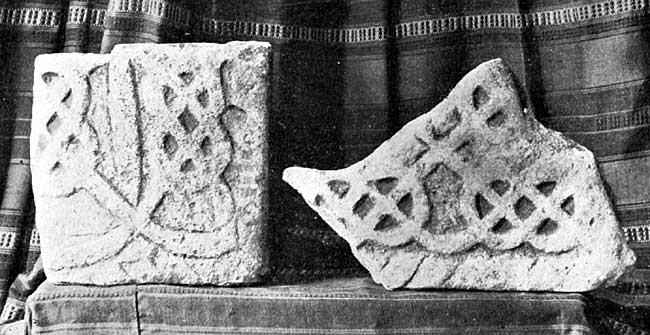Discovery of a Saxon Grave-Cover
By W. H. Mason, Morton Hall, Retford.

FRAGMENTS OF SAXON GRAVE COVER FOUND AT COATES, NOTTS.
A FEW years ago two stones with Anglo-Saxon carving on them, were found among some farm buildings at Coates, Notts. One was used as a coping stone for a wall, the other as a flagstone of the causeway in the farmyard.
Coates is in the joint parishes of North Leverton and Habblesthorpe, close to the Trent, and about three-quarters of a mile, as the crow flies, to the south of Littleborough. Therefore, though it was not in the ancient diocese of Dorchester, it was brought into close connexion with that diocese by means of Littleborough ferry.
The grave-cover, of course, may originally have been placed on the other side of the Trent, and broken up in more modern times for building purposes, and transported across the river.
Though the hamlet of Coates now consists of only three houses, it may formerly have been of more importance, both from its proximity to Littleborough, and also perhaps from its lying on or near the Roman road, which, it seems hardly doubtful, ran from Littleborough to Retford. That road, for some reason, appears to have deviated to the south on leaving Littleborough, for a lane which runs from Coates to Habblesthorpe is called "Street Lane."
However, there is no record of any church or chapel having existed at Coates; and therefore the grave-cover probably was brought from elsewhere, after having been broken up.
The following letter from no less an authority than the Bishop of Bristol, written in 1895, will be read with interest :—
"These are very interesting pieces, not of a cross but of a grave-cover, the main idea being the division of the stone into four panels by a raised Latin cross. The interlacing pattern comes in these four sunk panels. One of the pieces is the smaller end; the other is nearer the top. You can estimate roughly their relative position by the width of the cable round the edge.
"It has been a very good grave-cover. A fairly considerable number of Angle-Saxon stones of this type are known, some of them perfect. They found three in the rebuilding of Peterborough, one of them in situ, grave and all.
"There is something unusual in the raised line on the end piece. It looks as if it had been merely part of a bar forming the stem of a Latin cross. And on the other piece there is no indication of a division bar at all. This latter points to the probability of their being parts of two stones, this you could test by the thickness of the stones. If that is not so, the cross has been rather indicated than fully worked out, and the upper part of the stone has been filled with interlacing work, with no dividing bar. Or, conceivably, the splay of the stone has been so great, that in the upper panels there was room for two rows of the ornament.
"It is a curious fact that all the fragments sent to me from Lincolnshire, for the last three or lour years, have had this figure-of-eight pattern, certainly five or six in number. And, further, the most remarkable pieces brought to my knowledge in the last seven or eight years, in the parts over which Aldhelm presided, are covered with the same pattern; and Lincoln and Sherborne were, alike, parts of the Dorchester diocese.
"Your fragments are well worth all the care you can give them. If the farmer has an eye for such things, there are no doubt other pieces ready for discovery. The coping of a wall is not very ancient, and both in that wall and in the roadway the other pieces are likely to be."
It has only to be added that no more pieces have been found, though such search as was possible without pulling down buildings has been made.
The end piece is 5½ inches in depth. The other fragment is more irregular at the back, having suffered more in the process of breaking up, but its extreme depth is also 5½ inches.

